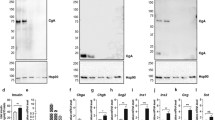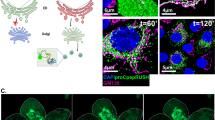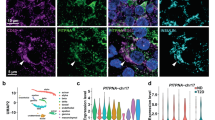Abstract
We recently reported that phogrin, also known as IA-2β or PTPRN2, forms a complex with the insulin receptor in pancreatic β cells upon glucose stimulation and stabilizes insulin receptor substrate 2. In β cells of systemic phogrin gene knockout (IA-2β−/−) mice, impaired glucose-induced insulin secretion, decreased insulin granule density, and an increase in the number and size of lysosomes have been reported. Since phogrin is expressed not only in β cells but also in various neuroendocrine cells, the precise impact of phogrin expressed in β cells on these cells remains unclear. In this study, we performed a comprehensive analysis of morphological changes in RIP-Cre+/−Phogrinflox/flox (βKO) mice with β cell-specific phogrin gene knockout. Compared to control RIP-Cre+/− Phogrin+/+ (Ctrl) mice, aged βKO mice exhibited a decreased density of insulin granules, which can be categorized into three subtypes. While no differences were observed in the density and size of lysosomes and crinosomes, organelles involved in insulin granule reduction, significant alterations in the regions of lysosomes responding positively to carbohydrate labeling were evident in young βKO mice. These alterations differed from those in Ctrl mice and continued to change with age. These electron microscopic findings suggest that phogrin expression in pancreatic β cells plays a role in insulin granule homeostasis and crinophagy during aging, potentially through insulin autocrine signaling and other mechanisms.








Similar content being viewed by others
Data availability
The datasets generated and analyzed during the current study are available from the corresponding author on reasonable request.
References
Arias AE, Vélez-Granell CS, Mayer G, Bendayan M (2000) Colocalization of chaperone Cpn60, proinsulin and convertase PC1 within immature secretory granules of insulin-secreting cells suggests a role for Cpn60 in insulin processing. J Cell Sci 113(Pt 11):2075–2083. https://doi.org/10.1242/jcs.113.11.2075
Blott EJ, Griffiths GM (2002) Secretory lysosomes. Nat Rev Mol Cell Biol 3(2):122–131. https://doi.org/10.1038/nrm732
Brouwers B, de Faudeur G, Osipovich AB, Goyvaerts L, Lemaire K, Boesmans L, Cauwelier EJ, Granvik M, Pruniau VP, Van Lommel L, Van Schoors J, Stancill JS, Smolders I, Goffin V, Binart N, In’t Veld P, Declercq J, Magnuson MA, Creemers JW, Schuit F, Schraenen A (2014) Impaired islet function in commonly used transgenic mouse lines due to human growth hormone minigene expression. Cell Metab 20(6):979–990. https://doi.org/10.1016/j.cmet.2014.11.004
Cai T, Notkins AL (2016) Pathophysiologic changes in IA-2/IA-2β null mice are secondary to alterations in the secretion of hormones and neurotransmitters. Acta Diabetol 53(1):7–12. https://doi.org/10.1007/s00592-015-0750-z
Cai T, Hirai H, Zhang G, Zhang M, Takahashi N, Kasai H, Satin LS, Leapman RD, Notkins AL (2011) Deletion of Ia-2 and/or Ia-2β in mice decreases insulin secretion by reducing the number of dense core vesicles. Diabetologia 54(9):2347–2357. https://doi.org/10.1007/s00125-011-2221-6
Clark A, Edwards CA, Ostle LR, Sutton R, Rothbard JB, Morris JF, Turner RC (1989) Localisation of islet amyloid peptide in lipofuscin bodies and secretory granules of human B-cells and in islets of type-2 diabetic subjects. Cell Tissue Res 257(1):179–185. https://doi.org/10.1007/BF00221649
Cnop M, Grupping A, Hoorens A, Bouwens L, Pipeleers-Marichal M, Pipeleers D (2000) Endocytosis of low-density lipoprotein by human pancreatic beta cells and uptake in lipid-storing vesicles, which increase with age. Am J Pathol 156(1):237–244. https://doi.org/10.1016/S0002-9440(10)64724-4
Cnop M, Hughes SJ, Igoillo-Esteve M, Hoppa MB, Sayyed F, van de Laar L, Gunter JH, de Koning EJ, Walls GV, Gray DW, Johnson PR, Hansen BC, Morris JF, Pipeleers-Marichal M, Cnop I, Clark A (2010) The long lifespan and low turnover of human islet beta cells estimated by mathematical modelling of lipofuscin accumulation. Diabetologia 53(2):321–330. https://doi.org/10.1007/s00125-009-1562-x
Csizmadia T, Juhász G (2020) Crinophagy mechanisms and its potential role in human health and disease. Prog Mol Biol Transl Sci 172:239–255. https://doi.org/10.1016/bs.pmbts.2020.02.002
Feng T, Mai S, Roscoe JM, Sheng RR, Ullah M, Zhang J, Katz II, Yu H, Xiong W, Hu F (2020) Loss of TMEM106B and PGRN leads to severe lysosomal abnormalities and neurodegeneration in mice. EMBO Rep 21(10):e50219. https://doi.org/10.15252/embr.202050219
Fukui K, Yasui T, Gomi H, Sugiya H, Fujimori O, Meyer W, Tsukise A (2012a) Histochemical localization of sialic acids and antimicrobial substances in eccrine glands of porcine snout skin. Eur J Histochem 56(1):e6. https://doi.org/10.4081/ejh.2012.e6
Fukui K, Yasui T, Gomi H, Sugiya H, Fujimori O, Meyer W, Tsukise A (2012b) Histochemical distribution of sialic acids and antimicrobial substances in porcine carpal glands. Arch Dermatol Res 304(8):599–607. https://doi.org/10.1007/s00403-012-1226-4
Gomi H, Mizutani S, Kasai K, Itohara S, Izumi T (2005) Granuphilin molecularly docks insulin granules to the fusion machinery. J Cell Biol 171(1):99–109. https://doi.org/10.1083/jcb.200505179
Gomi H, Kubota-Murata C, Yasui T, Tsukise A, Torii S (2013) Immunohistochemical analysis of IA-2 family of protein tyrosine phosphatases in rat gastrointestinal endocrine cells. J Histochem Cytochem 61(2):156–168. https://doi.org/10.1369/0022155412466872
Gomi H, Morikawa S, Shinmura N, Moki H, Yasui T, Tsukise A, Torii S, Watanabe T, Maeda Y, Hosaka M (2015) Expression of secretogranin III in chicken endocrine cells: its relevance to the secretory granule properties of peptide prohormone processing and bioactive amine content. J Histochem Cytochem 63(5):350–366. https://doi.org/10.1369/0022155415575032
Gomi H, Hinata A, Yasui T, Torii S, Hosaka M (2021) Expression pattern of the LacZ reporter in secretogranin III gene-trapped mice. J Histochem Cytochem 69(4):229–243. https://doi.org/10.1369/0022155421996845
Gomi H, Nagumo T, Asano K, Konosu M, Yasui T, Torii S, Hosaka M (2022) Differential expression of secretogranins II and III in canine adrenal chromaffin cells and pheochromocytomas. J Histochem Cytochem 70(5):335–356. https://doi.org/10.1369/00221554221091000
Habata I, Yasui T, Fujimori O, Meyer W, Tsukise A (2012) Histochemical analyses of glycoconjugates and antimicrobial substances in goat labial glands. Acta Histochem 114(5):454–462. https://doi.org/10.1016/j.acthis.2011.08.006
Hawkes CJ, Wasmeier C, Christie MR, Hutton JC (1996) Identification of the 37-kDa antigen in IDDM as a tyrosine phosphatase-like protein (phogrin) related to IA-2. Diabetes 45(9):1187–1192. https://doi.org/10.2337/diab.45.9.1187
Henquin JC, Nenquin M, Szollosi A, Kubosaki A, Notkins AL (2008) Insulin secretion in islets from mice with a double knockout for the dense core vesicle proteins islet antigen-2 (IA-2) and IA-2β. J Endocrinol 196(3):573–581. https://doi.org/10.1677/JOE-07-0496
Herrera PL (2000) Adult insulin- and glucagon-producing cells differentiate from two independent cell lineages. Development 127(11):2317–2322. https://doi.org/10.1242/dev.127.11.2317
Kang T, Ye J, Qin P, Li H, Yao Z, Liu Y, Ling Y, Zhang Y, Yu T, Cao H, Li Y, Wang J, Fang F (2021) Knockdown of Ptprn-2 delays the onset of puberty in female rats. Theriogenology 176:137–148. https://doi.org/10.1016/j.theriogenology.2021.09.029
Kawasaki E, Hutton JC, Eisenbarth GS (1996) Molecular cloning and characterization of the human transmembrane protein tyrosine phosphatase homologue, phogrin, an autoantigen of type 1 diabetes. Biochem Biophys Res Commun 227(2):440–447. https://doi.org/10.1006/bbrc.1996.1526
Kawasaki E, Yu L, Rewers MJ, Hutton JC, Eisenbarth GS (1998) Definition of multiple ICA512/phogrin autoantibody epitopes and detection of intramolecular epitope spreading in relatives of patients with type 1 diabetes. Diabetes 47(5):733–742. https://doi.org/10.2337/diabetes.47.5.733
Kubosaki A, Gross S, Miura J, Saeki K, Zhu M, Nakamura S, Hendriks W, Notkins AL (2004) Targeted disruption of the IA-2β gene causes glucose intolerance and impairs insulin secretion but does not prevent the development of diabetes in NOD mice. Diabetes 53(7):1684–1691. https://doi.org/10.2337/diabetes.53.7.1684
Kubosaki A, Nakamura S, Notkins AL (2005) Dense core vesicle proteins IA-2 and IA-2β: metabolic alterations in double knockout mice. Diabetes 54(Suppl 2):S46-51. https://doi.org/10.2337/diabetes.54.suppl_2.S46
Kubosaki A, Nakamura S, Clark A, Morris JF, Notkins AL (2006) Disruption of the transmembrane dense core vesicle proteins IA-2 and IA-2β causes female infertility. Endocrinology 147(2):811–815. https://doi.org/10.1210/en.2005-0638
Kushner JA, Haj FG, Klaman LD, Dow MA, Kahn BB, Neel BG, White MF (2004) Islet-sparing effects of protein tyrosine phosphatase-1b deficiency delays onset of diabetes in IRS2 knockout mice. Diabetes 53(1):61–66. https://doi.org/10.2337/diabetes.53.1.61
Lam PP, Ohno M, Dolai S, He Y, Qin T, Liang T, Zhu D, Kang Y, Liu Y, Kauppi M, Xie L, Wan WC, Bin NR, Sugita S, Olkkonen VM, Takahashi N, Kasai H, Gaisano HY (2013) Munc18b is a major mediator of insulin exocytosis in rat pancreatic β-cells. Diabetes 62(7):2416–2428. https://doi.org/10.2337/db12-1380
Marsh BJ, Soden C, Alarcón C, Wicksteed BL, Yaekura K, Costin AJ, Morgan GP, Rhodes CJ (2007) Regulated autophagy controls hormone content in secretory-deficient pancreatic endocrine beta-cells. Mol Endocrinol 21(9):2255–2269. https://doi.org/10.1210/me.2007-0077
Masini M, Marselli L, Bugliani M, Martino L, Masiello P, Marchetti P, De Tata V (2012) Ultrastructural morphometric analysis of insulin secretory granules in human type 2 diabetes. Acta Diabetol 49(Suppl 1):S247-252. https://doi.org/10.1007/s00592-012-0446-6
Mziaut H, Kersting S, Knoch KP, Fan WH, Trajkovski M, Erdmann K, Bergert H, Ehehalt F, Saeger HD, Solimena M (2008) ICA512 signaling enhances pancreatic β-cell proliferation by regulating cyclins D through STATs. Proc Natl Acad Sci USA 105(2):674–679. https://doi.org/10.1073/pnas.0710931105
Nakajima K, Wu G, Takeyama N, Sakudo A, Sugiura K, Yukawa M, Onodera T (2009) Insulinoma-associated protein 2-deficient mice develop severe forms of diabetes induced by multiple low doses of streptozotocin. Int J Mol Med 4(1):23–27. https://doi.org/10.3892/ijmm_00000201
Nakajima K, Wu G, Sakudo A, Onodera T, Takeyama N (2011) Distinct subcellular localization of three isoforms of insulinoma-associated protein 2β in neuroendocrine tissues. Life Sci 88(17–18):798–802. https://doi.org/10.1016/j.lfs.2011.02.018
Nara T, Yasui T, Gomi H, Sugiya H, Fujimori O, Meyer W, Tsukise A (2013) Cytochemistry of sialoglycoconjugates and lysozyme in canine anal glands as studied by electron microscopic methods. Acta Histochem 115(3):226–233. https://doi.org/10.1016/j.acthis.2012.06.011
Newman GR, Jasani B, Williams ED (1983) A simple post-embedding system for the rapid demonstration of tissue antigens under the electron microscope. Histochem J 15(6):543–555. https://doi.org/10.1007/BF01954145
Norris N, Yau B, Kebede MA (2021) Isolation and proteomics of the insulin secretory granule. Metabolites 11(5):288. https://doi.org/10.3390/metabo11050288
Ostman A, Frijhoff J, Sandin A, Böhmer FD (2011) Regulation of protein tyrosine phosphatases by reversible oxidation. J Biochem 150(4):345–356. https://doi.org/10.1093/jb/mvr104
Raleigh D, Zhang X, Hastoy B, Clark A (2017) The β-cell assassin: IAPP cytotoxicity. J Mol Endocrinol 59(3):R121-140. https://doi.org/10.1530/JME-17-0105
Ramírez-Franco JJ, Munoz-Cuevas FJ, Luján R, Jurado S (2016) Excitatory and inhibitory neurons in the hippocampus exhibit molecularly distinct large dense core vesicles. Front Cell Neurosci 10:202. https://doi.org/10.3389/fncel.2016.00202
Rao A, McBride EL, Zhang G, Xu H, Cai T, Notkins AL, Aronova MA, Leapman RD (2020) Determination of secretory granule maturation times in pancreatic islet β-cells by serial block-face electron microscopy. J Struct Biol 212(1):107584. https://doi.org/10.1016/j.jsb.2020.107584
Rother E, Belgardt BF, Tsaousidou E, Hampel B, Waisman A, Myers MG Jr, Brüning JC (2012) Acute selective ablation of rat insulin promoter-expressing (RIPHER) neurons defines their orexigenic nature. Proc Natl Acad Sci USA 109(44):18132–18137. https://doi.org/10.1073/pnas.1206147109
Saeki K, Zhu M, Kubosaki A, Xie J, Lan MS, Notkins AL (2002) Targeted disruption of the protein tyrosine phosphatase-like molecule IA-2 results in alterations in glucose tolerance tests and insulin secretion. Diabetes 51(6):1842–1850. https://doi.org/10.2337/diabetes.51.6.1842
Saito N, Takeuchi T, Kawano A, Hosaka M, Hou N, Torii S (2011) Luminal interaction of phogrin with carboxypeptidase E for effective targeting to secretory granules. Traffic 12(4):499–506. https://doi.org/10.1111/j.1600-0854.2011.01159.x
Schindelin J, Arganda-Carreras I, Frise E, Kaynig V, Longair M, Pietzsch T, Preibisch S, Rueden C, Saalfeld S, Schmid B (2012) Fiji: an open-source platform for biological-image analysis. Nature Method 9(7):676–682. https://doi.org/10.1038/nmeth.2019
Sokanovic SJ, Constantin S, Lamarca Dams A, Mochimaru Y, Smiljanic K, Bjelobaba I, Prévide RM, Stojilkovic SS (2023) Common and female-specific roles of protein tyrosine phosphatase receptors N and N2 in mice reproduction. Sci Rep 13(1):355. https://doi.org/10.1038/s41598-023-27497-4
Solimena M, Dirkx R Jr, Hermel JM, Pleasic-Williams S, Shapiro JA, Caron L, Rabin DU (1996) ICA 512, an autoantigen of type I diabetes, is an intrinsic membrane protein of neurosecretory granules. EMBO J 15(9):2102–2114. https://doi.org/10.1002/j.1460-2075.1996.tb00564.x
Song J, Xu Y, Hu X, Choi B, Tong Q (2010) Brain expression of Cre recombinase driven by pancreas-specific promoters. Genesis 48(11):628–634. https://doi.org/10.1002/dvg.20672
Speidel D, Salehi A, Obermueller S, Lundquist I, Brose N, Renström E, Rorsman P (2008) CAPS1 and CAPS2 regulate stability and recruitment of insulin granules in mouse pancreatic beta cells. Cell Metab 7(1):57–67. https://doi.org/10.1016/j.cmet.2007.11.009
Szenci G, Csizmadia T, Juhász G (2023) The role of crinophagy in quality control of the regulated secretory pathway. J Cell Sci 136(8):jcs260741. https://doi.org/10.1242/jcs.260741
Takahashi N, Hatakeyama H, Okado H, Miwa A, Kishimoto T, Kojima T, Abe T, Kasai H (2004) Sequential exocytosis of insulin granules is associated with redistribution of SNAP25. J Cell Biol 165(2):255–262. https://doi.org/10.1083/jcb.200312033
Takeyama N, Ano Y, Wu G, Kubota N, Saeki K, Sakudo A, Momotani E, Sugiura K, Yukawa M, Onodera T (2009) Localization of insulinoma associated protein 2, IA-2 in mouse neuroendocrine tissues using two novel monoclonal antibodies. Life Sci 84(19–20):678–687. https://doi.org/10.1016/j.lfs.2009.02.012
Tiganis T (2013) PTP1B and TCPTP–nonredundant phosphatases in insulin signaling and glucose homeostasis. FEBS J 280(2):445–458. https://doi.org/10.1111/j.1742-4658.2012.08563.x
Torii S, Saito N, Kawano A, Hou N, Ueki K, Kulkarni RN, Takeuchi T (2009) Gene silencing of phogrin unveils its essential role in glucose-responsive pancreatic β-cell growth. Diabetes 58(3):682–692. https://doi.org/10.2337/db08-0970
Torii S, Kubota C, Saito N, Kawano A, Hou N, Kobayashi M, Torii R, Hosaka M, Kitamura T, Takeuchi T, Gomi H (2018) The pseudophosphatase phogrin enables glucose-stimulated insulin signaling in pancreatic β cells. J Biol Chem 293(16):5920–5933. https://doi.org/10.1074/jbc.RA117.000301
Trajkovski M, Mziaut H, Schubert S, Kalaidzidis Y, Altkrüger A, Solimena M (2008) Regulation of insulin granule turnover in pancreatic beta-cells by cleaved ICA512. J Biol Chem 283(48):33719–33729. https://doi.org/10.1074/jbc.M804928200
Wang HH, Cui Q, Zhang T, Wang ZB, Ouyang YC, Shen W, Ma JY, Schatten H, Sun QY (2016) Rab3A, Rab27A, and Rab35 regulate different events during mouse oocyte meiotic maturation and activation. Histochem Cell Biol 145(6):647–657. https://doi.org/10.1007/s00418-015-1404-5
Wasmeier C, Hutton JC (1996) Molecular cloning of phogrin, a protein-tyrosine phosphatase homologue localized to insulin secretory granule membranes. J Biol Chem 271(30):18161–18170. https://doi.org/10.1074/jbc.271.30.18161
Yamada K (1993) Histochemistry of carbohydrates as performed by physical development procedures. Histochem J 25(2):95–106. https://doi.org/10.1007/BF00157980
Yasui T, Tsukise A, Meyer W (2003) Histochemical analysis of glycoconjugates in the ceruminous glands of the North American raccoon (Procyon lotor). Ann Anat 185(3):223–231. https://doi.org/10.1016/S0940-9602(03)80028-6
Yasui T, Tsukise A, Habata I, Nara T, Meyer W (2004) Histochemistry of complex carbohydrates in the ceruminous glands of the goat. Arch Dermatol Res 296(1):12–20. https://doi.org/10.1007/s00403-004-0464-5
Yasui T, Tsukise A, Meyer W (2005) Ultracytochemical demonstration of glycoproteins in the eccrine glands of the digital pads of the North American raccoon (Procyon lotor). Anat Histol Embryol 34(1):56–60. https://doi.org/10.1111/j.1439-0264.2004.00577.x
Yasui T, Tsukise A, Miura T, Fukui K, Meyer W (2006) Cytochemical characterization of glycoconjugates in the apocrine glands of the equine scrotal skin. Arch Histol Cytol 69(2):109–117. https://doi.org/10.1679/aohc.69.109
Yasui T, Miyata K, Nakatsuka C, Tsukise A, Gomi H (2021) Morphological and histochemical characterization of the secretory epithelium in the canine lacrimal gland. Eur J Histochem 65(4):3320. https://doi.org/10.4081/ejh.2021.3320
Zahn TR, Macmorris MA, Dong W, Day R, Hutton JC (2001) IDA-1, a Caenorhabditis elegans homolog of the diabetic autoantigens IA-2 and phogrin, is expressed in peptidergic neurons in the worm. J Comp Neurol 429(1):127–143
Acknowledgements
The authors thank Mrs. Mari Hosoi (Gunma University, Maebashi, Japan) for her assistance in mouse breeding.
Funding
This study was supported by Grants-in-Aid from the Japan Society for the Promotion of Science (JSPS) #25450471, #16K08078, #20K06418 (to HG), #24390050, #17K08528, and #20H05310 (to ST). It was also supported in part by the joint research program of the Institute for Molecular and Cellular Regulation, Gunma University (No. 15012 and 18015; to HG and ST) and the Nihon University College of Bioresource Sciences Research Grant for 2019–2022 (to HG and TY).
Author information
Authors and Affiliations
Contributions
TY, HG, MM, AO, HM, MI-M, HH, SK, and CK performed the histological experiments and analyzed the histological image data. HG and ST designed and conducted this study. CK and ST prepared anti-phogrin mouse monoclonal antibody, generated phogrin βKO mice, and fixed the tissue specimens obtained from mice. HG, CK, and ST performed biochemical analyses. HG prepared the original draft of the manuscript. MH contributed to experimental design and reviewed the manuscript. ST and HG revised and edited the draft. The final manuscript has been read and approved by all authors.
Corresponding author
Ethics declarations
Conflict of interest
The authors declare that the research was conducted in the absence of any commercial or financial relationships that could be construed as a potential conflict of interest.
Additional information
Publisher's Note
Springer Nature remains neutral with regard to jurisdictional claims in published maps and institutional affiliations.
Supplementary Information
Below is the link to the electronic supplementary material.
Rights and permissions
Springer Nature or its licensor (e.g. a society or other partner) holds exclusive rights to this article under a publishing agreement with the author(s) or other rightsholder(s); author self-archiving of the accepted manuscript version of this article is solely governed by the terms of such publishing agreement and applicable law.
About this article
Cite this article
Yasui, T., Mashiko, M., Obi, A. et al. Insulin granule morphology and crinosome formation in mice lacking the pancreatic β cell-specific phogrin (PTPRN2) gene. Histochem Cell Biol 161, 223–238 (2024). https://doi.org/10.1007/s00418-023-02256-8
Accepted:
Published:
Issue Date:
DOI: https://doi.org/10.1007/s00418-023-02256-8




